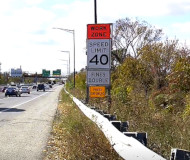7/31/2020
DC Denies Wrongdoing In Freeway Speed Camera TrapDC government asks judge to toss lawsuit against speed camera trap on Interstate 295, saying nothing it did was shocking or outrageous.

Washington, DC, does not want to repay motorists caught in a freeway speed camera trap. A lawsuit filed in March challenged the use of automated ticketing machines on a section of Interstate 295 where the speed limit plunged from 50 MPH to 40 MPH and a lone sign on the side of the road marked the change. That sign could be missed if a truck or other large vehicle were to obstruct its view. Lawyers for Mayor Muriel Bowser now insist the lawsuit needs to be thrown out because the "work zone" has been moved away from the location in question.
City officials had lowered the speed limit to 40 MPH and doubled the fine to $200 during a construction project that began in May 2019. After finishing work on the Anacostia Bridge in December 2019, however, the city moved the 40 MPH speed limit reduction that is included in the suit to another section of the interstate.
"The speed cameras were recalibrated to issue citations based on the 50 miles per hour speed limit, and the District stopped imposing doubled civil fines for speeding infractions issued by these two cameras," city attorney Karl A. Racine wrote.
Only one of the speed camera locations in the initial lawsuit complaint remains within a lowered speed limit area.
"The Matthewses do not allege that they drive on Route 295 near the Exit 2 Camera or are otherwise likely to receive any future citations with unlawfully doubled civil fines, and as such, they do not face any immediate threat of future injury and do not have standing to seek injunctive relief," Racine told the court.
The motorists also argued that it was unconstitutionally excessive to impose the $200 fine for allegedly driving over 40 MPH in a freeway "work zone" where no actual work was being performed. One plaintiff was charged for allegedly driving 52 MPH and another 56 MPH because they believed the 50 MPH speed limit applied.
"Even if the speed limit had not been reduced to 40 miles per hour, the $200 was not grossly disproportionate to the offense: each plaintiff was still driving in excess of the standard 50 miles per hour speed limit," Racine wrote. "Plaintiffs challenge the allegedly unlawful designation of a particular area of highway as a work zone, and the imposition and collection of doubled fines for traffic violations in that area. This fails to meet the requirement of 'egregious' or 'outrageous' conduct."
Judge Dabney L. Friedrich gave motorists until August 5 to respond to the city.


